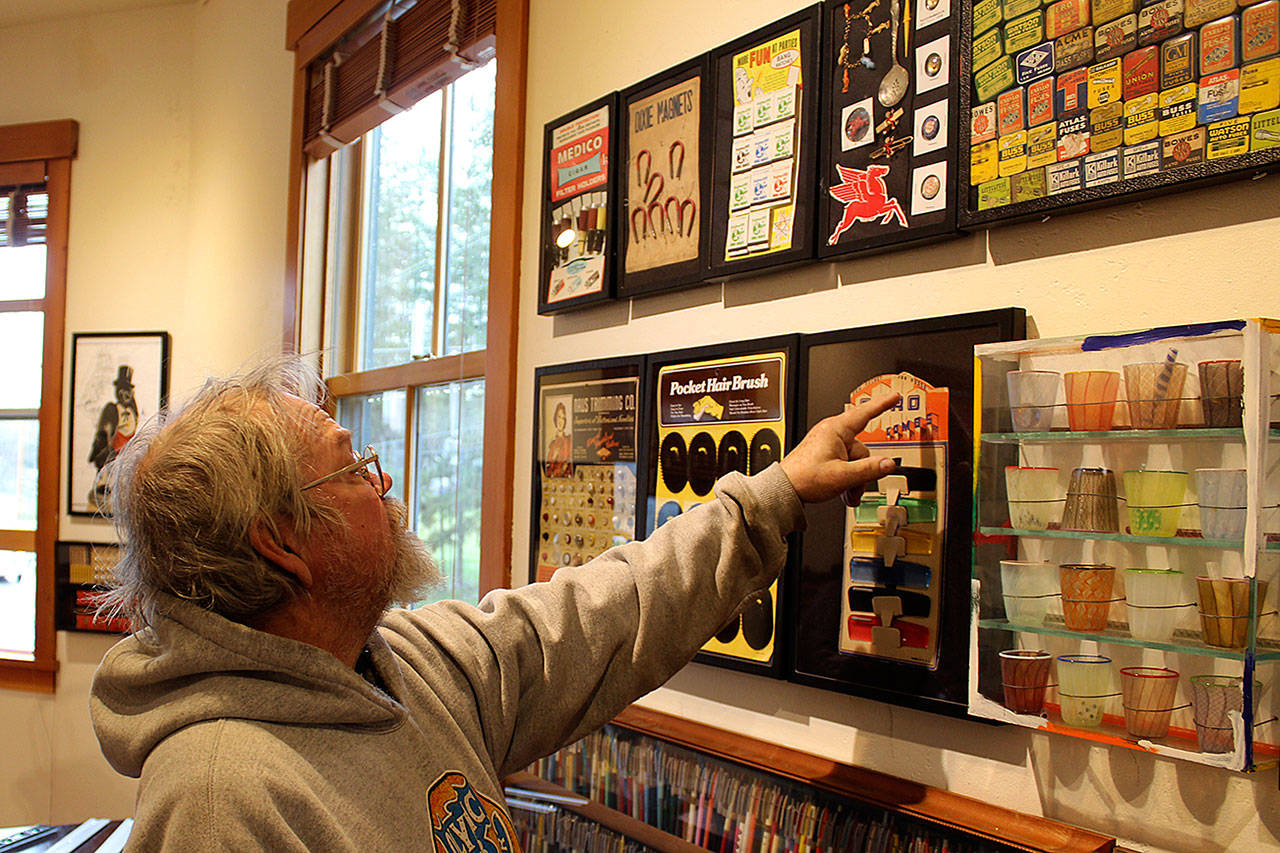Meet Richard Marquis, world-famous glass artist.
Meet Dick Marquis, Whidbey recluse and collector of vintage stuff.
One and the same, they come together in the Front Room Gallery at Bayview Corner where the show, “Found Objects” is on display until April 29.
It features the quirky collectibles of Marquis, who lives in an undisclosed location, somewhere in Freeland, with his artist wife, Johanna Nitzke Marquis. They’ve lived there for 35 years, surrounded by various dogs, cats and birds. And a whole lot of stuff.
Marquis, 72, is relatively unknown on Whidbey because that’s the way he prefers it.
But in the glass art world, he’s considered an innovative, technical master, an elder statesman, one who’s had an extraordinary influence on the development of glass as art in America.
Not that you’d deduce that from meeting him.
Dressed in jeans, rumpled sweatshirt and topped with a high-wind hairdo almost as strange as the president, he acquiesced to an interview last week as he and a friend arranged his collection.
“Yes, I’m an artist and have pieces in the Metropolitan Museum of Art and Seattle Art Museum, but here I’m showing mostly stuff I’ve collected, found objects. But hardly anything will be for sale,” he explained.
Which is amusing, because back in the real world there’s online bidding wars for some of Marquis’ older pieces. One of his signed blown glass teapots is topping $12,500. The asking price for his Gene Autrey toy pistol — where he removed the plastic handle and replaced it with a pattern of intricate inlaid glass — is $7,250.
But that side of him slips away in this installation of a slice of American life.
It’s a trip back in time when the advertising of common items, such as combs, cigarette lighters, fuses, cigar holders and soap, was an art form designed to catch the eye and wallet of shoppers in mom and pop stores.
Some are iconic symbols — the flying red Pegasus of Mobil, the glasses and top hat of Old Crow Bourbon — and some are real head-scratchers.
“Look at these,” Marquis says, pointing to figurines lined up in rows. “They’re all salt and pepper shakers from World War II.” Snuffy Smith, pairs of dogs and cats, many versions of bomb-shaped shakers with the word “Victory Bombs” are in the mix.
“But they’re all made of plaster,” he points out. “How stupid is that?”
For the past several months, friends and relatives helped Marquis sort, organize and catalogue the collection that he’s showing for the first time. “It seemed like a good idea,” he said. “But other times I thought ‘why am I doing this?’ It’s so much trouble.”
Walking around, Marquis points out graphic patterns and colors of advertising cards that’s he’s framed in Ikea shadow boxes. “I find them interesting from a design standpoint,” he said. “I mostly make three-dimensional objects so I put some of my work in sample boxes along with the collections.”
There’s six pieces of Marquis’ glass work hanging with the “Found Objects” collection that reveal his style, artistry and mastery of Venetian cane and murrine techniques. Many of his more humorous glass series use items from his collection.
“As a kid, I collected mostly coins and stamps and my brother and I had a collection of hand puppets and string puppets,” Marquis recalled. “But my family moved around a lot and things got left behind.”
At age 24 after receiving a full ride at UC Berkeley, a Fulbright scholarship (one of three he received) took Marquis to the island of Murano to observe and work with the world’s traditional masters of glassblowing.
Almost 50 years later, his work can be found in the collections of the Metropolitan Museum of Art, American Glass Museum, Carnegie Mellon Museum of Art, the Corning Museum of Glass, among others. He’s taught throughout the United States, Europe, Japan, Australia, and New Zealand.
Next month, Marquis has been asked to demonstrate at the Glass Art Society convention in Venice.
“He’s right up there with (Dale) Chihuly,” said KeKe Cribbs, who manages the Front Room Gallery and Treasure Trove for the non-profit Goosefoot. “But nobody knows him here.”
www.frontroomgallerybayview.com


